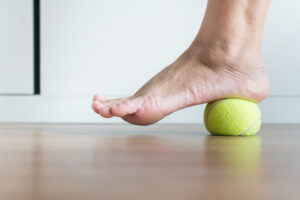Though we often feel invincible when we’re young, an active lifestyle can sometimes lead to some pretty common injuries. According to Michael Smith, PA-C, ATC with First Response Orthopedic Group, “A critical part of injury prevention is a combination of mobility, flexibility and correcting strength imbalances.” Here we take a look at three common problem areas and what you can do to treat or even prevent pain.
The below is not meant to replace professional medical attention. As always, we at Captyn suggest that if you’re in pain, seek medical care.
Shoulders:
The shoulder is an incredibly complex joint that serves many functions. In most fitness routines, resistance training is an integral component. Excess lifting or improper technique can often lead to such ailments as tendinitis, bursitis, impingements and tears within the shoulder.
Many shoulder issues stem from a lack of external rotation of the shoulder. Try working corrective movements that externally rotate the shoulder into the end of your resistance training sessions. Band pull-aparts and side-lying dumbbell or plate rotations in the scapular plane are fantastic moves to incorporate for overall shoulder strength and health, but the key is “making sure they are done correctly,” advises Miguel Gonzalez, MS, ATC, LAT.
Mr. Gonzalez, an Injury Prevention Specialist at the Micheli Center for Sports Injury Prevention and former assistant Athletic Trainer for the Boston Red Sox, strongly recommends “face-pulls as they work the scapular retraction motion of the scapula and landmine presses because oftentimes the scapula sits in scapular depression and needs to be put into an upward rotating motion, which is its most important function.” Light weight and quality movement is best for the shoulder and also ensuring you incorporate all of the movement directions for each part worked on.

Hips / Knees:
“At the hip, typical imbalances include tight hip flexors and weak glutes / core musculature,” Mr. Smith advises. Movements that target these weak points as well as movements that work the posterior chain are ideal. Glute bridges, planks with movement variations, multi-plane lunges and hinge-based exercises will be best. For hip flexors specifically, hip clams or Jane Fondas (yes, just like the old workout videos) will be beneficial. In endurance athletes, patellar tendinitis (pain just below the knee) is a commonality that can result from weak hip flexors.
“At the knee, VMO (vastus medialis oblique) weakness and IT band (iliotibial band) tightness is a typical cause of knee pain in endurance athletes.” One way to prevent this is isometric hold and adduction. Seated, place a ball between your thighs and squeeze, holding this contraction for ten seconds. Rest for ten seconds and then repeat the process four times.

Feet:
Many individuals, especially those that run for fitness, fall victim to stabbing pain under their foot or both feet closer to their heel. This is likely plantar fasciitis, which is the result of inflammation of the tissue that runs along the bottom of your foot. Looking for a simple, at-home treatment? Roll a frozen water bottle along the bottom of your foot. If you have a lacrosse ball or spikey ball, another option is to roll with that but also to perform trigger point release exercises, like those found here.


